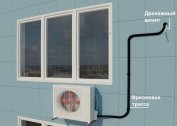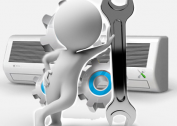Having waited for the warm spring days and saying goodbye to the annoying winter, we remove heating appliances away and recall another technique that can not be dispensed with in the summer heat. In our article we will talk about air conditioners. Do you know how to prepare it for the new season? And how to wash and clean? Let's get it together.
Preparation for launch after winter
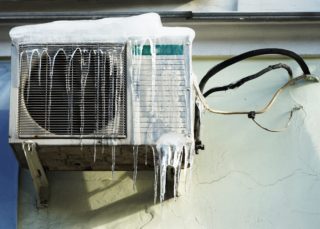 A long winter stagnation does not benefit the appliance, but rather the opposite - the risk of breakdown increases several times if the owner does not carry out the first launch according to the rules.
A long winter stagnation does not benefit the appliance, but rather the opposite - the risk of breakdown increases several times if the owner does not carry out the first launch according to the rules.
- The first launch can be carried out with specific air temperature. Allowable values are indicated in the instructions for the air conditioner: for some models only positive indicators are permissible, for others - a range from 0 to -5 degrees.
- Inspect the outdoor unit. It can be damaged by precipitation (snow, hail, icicles), deformed under the influence of other external factors. Check: if small branches, fluff, leaves and other debris got into the fan blades - it can be carried by a strong wind through the protective grill. Remove all obstacles that interfere with the normal air circulation near it.
- Flush all parts (both inside and out) with soapy water. To clean the indoor unit, a compressor with compressed air will be needed - it copes with accumulations of dust and dirt in hard-to-reach places. Wipe the grill and small parts properly.
- Inspect electrical contacts for wire breaks, breaks and other damage. But visual inspection is usually not enough and malfunctions are most often detected during the start of the air conditioner. It is best to call a specialist who will check with special instruments. By the way, if you find a breakdown - you still have to call a specialist.
- Check Freon Level - its leakage is a natural phenomenon (with the exception of leakage into cracks in the nozzles), a feature of the connection of the indoor and outdoor units, but without refueling the technician will work for “wear”, wasting electricity in vain, and sooner or later will fail. For humans, freon is not dangerous.
- Another mandatory action is to determine the pressure in the system. It is also better to entrust it to a specialist.
Before cleaning, be sure to disconnect the appliance from the power supply so that the moving blades do not injure you.
In order for the air conditioner to survive the winter without any problems, it must be “mothballed” for this time. Service employees pump refrigerant into the outdoor unit, block the ability to turn on the device and protect the outdoor unit from icicles.
First start recommendations
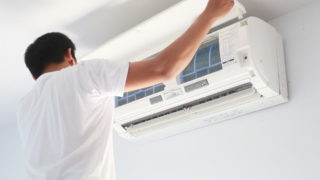
- Plug in the appliance. The temperature in the room should not be lower than +20 degrees.
- Set the cooling mode to +18 (at maximum fan speed) and let the air conditioner work for 15-20 minutes.
- After that you can check the remote control. Start and move the “curtains”, switch the speeds, change the temperature mode - the device must respond to all commands without delay: change the direction of the air stream, move, etc.
It is recommended to contact a specialist in the following cases:
- If the outdoor unit is badly damaged (for example, the case was broken by a stone strike or as a result of a drop of ice block);
- If the air goes too warm;
- You hear extraneous noise, hum, banging;
- The radiator of the outdoor unit is very dirty and you cannot clean it yourself;
- The remote does not respond to commands, but the batteries in it are fresh;
- The air conditioner refuses to start.
Operational Prevention
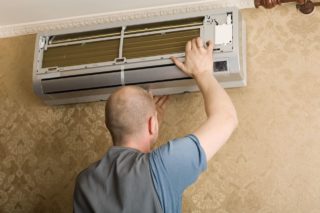 The longer you use the air conditioner, the more fat, mucus and dust accumulate in its body, filter unit and fan. Fungi and bacteria that appear next, I get into the room with a stream of air, and then into the lungs of the residents. It is easy to guess that this affects the health in the most negative way. Pollution worsens the operation of the nodes, the process of updating the air worsens, the load on the device and the electric network grows 2 times. A layer of fluff builds up on the external unit of the device, which disrupts the activity of the heat exchanger and impairs the cooling process of the refrigerant. If you want to eliminate lung problems and extend the life of the device, train yourself to clean and disinfect the air conditioner according to a certain schedule.
The longer you use the air conditioner, the more fat, mucus and dust accumulate in its body, filter unit and fan. Fungi and bacteria that appear next, I get into the room with a stream of air, and then into the lungs of the residents. It is easy to guess that this affects the health in the most negative way. Pollution worsens the operation of the nodes, the process of updating the air worsens, the load on the device and the electric network grows 2 times. A layer of fluff builds up on the external unit of the device, which disrupts the activity of the heat exchanger and impairs the cooling process of the refrigerant. If you want to eliminate lung problems and extend the life of the device, train yourself to clean and disinfect the air conditioner according to a certain schedule.
Home air conditioners should be cleaned every 6-8 months. Devices located in office premises - every 3-4 months. Split systems installed in cafeterias and other public places - once every 30 days.
The following symptoms indicate pollution:
- Unpleasant smell that appears during the work;
- Unstable sound, crackle;
- Leaking from the internal module;
- Undercooling.
First of all, it is necessary to check the tightness of the freon circuit: are there any irregularities due to which moisture can get inside, and is freon leaking? Tighten the fixing screws, and the fixing screws, remove the front cover and strainer. Soak the net in a soap solution (dissolve a couple of spoons of soap chips in a bowl of water) or any detergent, wipe with a stiff brush.
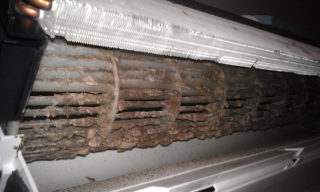 The next step is to clean the fan. They come in 2 types: fixed and removable. Removable washed in soapy water, non-removable cleaned with a brush (not very convenient, but the dirt is removed well). If the blades smell bad - disinfect them with a special tool.
The next step is to clean the fan. They come in 2 types: fixed and removable. Removable washed in soapy water, non-removable cleaned with a brush (not very convenient, but the dirt is removed well). If the blades smell bad - disinfect them with a special tool.
The radiator and heat exchanger are most often located in the indoor unit that needs to be disassembled. The after-sales service asks for a significant amount for such work, but you can save and do it yourself. Remove the front cover and remove the filters. A vacuum cleaner will help you clean the insides: remove dust and fluff, moving from the top to the bottom. Evaporator plates are very fragile and easy to damage, so use a long-brushed brush to clean them. You can use a steam cleaner. After setting the split system in recirculation mode, set the lowest temperature threshold and spray an antiseptic in the air intake area. Make sure that liquid droplets do not get on the radiator!
The drainage system consists of 2 parts: a pan in which excess fluid accumulates, and a tube for draining water. Over time, both there and there appears fungus and mold, an unpleasant odor, begins to drip from the device. The pallet is disconnected from the outlet pipe and the board, and washed in running water, and the tube is purged with a compressor or vacuum cleaner.
The heat exchanger is cleaned with a special foam or spray.
Cleaning the external unit can be dangerous - when the module is located high above the ground and it is difficult to get to it. Do not risk your life, but call a specialist with special equipment.
Popular cleaning products are: DOMO, FavorCOOL, TOP House, Techpoint.
If you want your air conditioner to work as long as possible and not cause any trouble, learn how to care for it and how to operate it correctly. Read the instructions carefully, do not rush to do the work in half an hour. And if there is any doubt in your abilities - call the service department. Spending money, you will save time and guaranteed to get the desired result.
